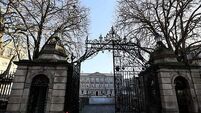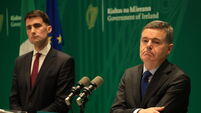Public finances remain in a perilous position
Granted this year’s borrowing figure includes just over €3bn in non-voted capital expenditure payments to Anglo Irish Bank and Irish Nationwide Building Society. This relates to the first 10% payments of the original principal sum of the promissory notes committed to those institutions in 2010, or at least that is what the Department of Finance told us at the end of March. It could be argued this €3bn should be factored out when analysing what is really going on in the economy, based on exchequer receipts and expenditure. The reality is that this figure cannot be factored out because it does represent Government borrowing; it will be added to the stock of outstanding national debt and will attract interest payments.
An analysis of the tax revenue figures for the first four months shows it running €108 million ahead of what the Department of Finance expected and 6.7% ahead of the same period last year. The latter growth rate exaggerates the true situation as it includes receipts from the Universal Social Charge (USC), which replaces the previous health and income levies. The health levy was previously regarded as a departmental receipt rather than tax revenue, and its inclusion in the USC exaggerates the growth in total tax revenues. This is all very technical and perhaps a bit confusing, but the underlying picture shows VAT receipts are very weak, primarily reflecting the weakness of consumer spending; excise duties are reasonably strong reflecting continued growth in car sales; and stamp duties and capital gains tax receipts are very weak.
Those on the left have always had a problem with the decision to halve the capital gains tax rate to 20% some years back and government acceded to the pressures and has pushed the rate up a bit in recent times. This might make those on the left happier in themselves, but the reality is that when the capital gains tax rate was originally halved, capital transactions picked up dramatically in the following years and the tax take under this particular heading soared. The reality today is that most Irish people wouldn’t recognise a capital gain if it stood up and bit them in the back. Increasing the rate just serves to depress any capital transactions that might otherwise occur.
Tax rates should only be increased if there is a chance it would result in increased tax revenues and not just to placate some outdated ideological bias.
On the expenditure side net voted current spending is 7% ahead of last year and net voted capital spending is running 31.8% behind last year. Current spending on social protection, which accounted for just over 30% of total current spending in the first four months of the year, is running 18% ahead of last year. This primarily reflected increased numbers signing on the live register, although that has dropped recently.
All in all, the state of the Irish public finances is still very perilous. Last week the Department of Finance submitted the updated Stability Programme to the EU, which takes account of Budget 2011, the Programme for Government and the joint EU/IMF Programme. Despite a downward revision to growth prospects, the department is still forecasting that the general government borrowing requirement will fall to 2.8% by 2015. This will require a fiscal adjustment of more than the anticipated €15bn between 2011 and 2014. This will be very difficult to achieve, given the still perilous state of the economy and banking sector.













